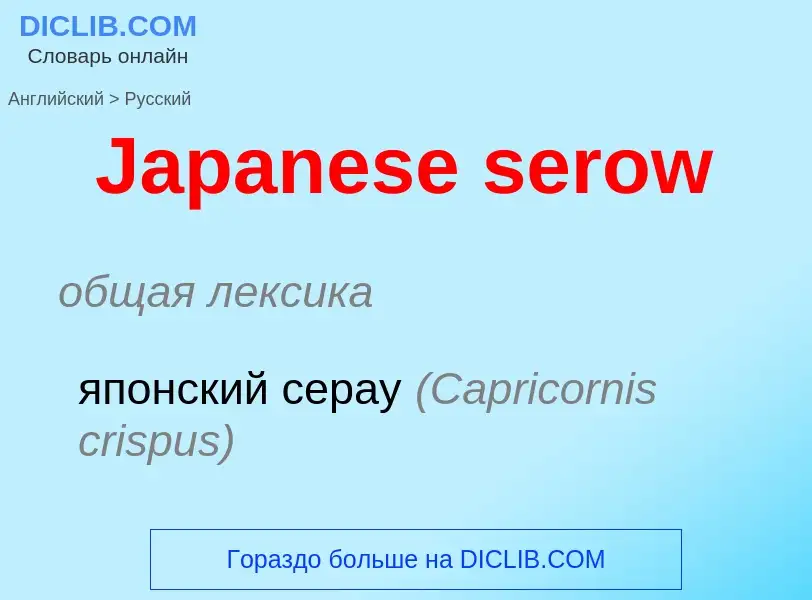Vertaling en analyse van woorden door kunstmatige intelligentie ChatGPT
Op deze pagina kunt u een gedetailleerde analyse krijgen van een woord of zin, geproduceerd met behulp van de beste kunstmatige intelligentietechnologie tot nu toe:
- hoe het woord wordt gebruikt
- gebruiksfrequentie
- het wordt vaker gebruikt in mondelinge of schriftelijke toespraken
- opties voor woordvertaling
- Gebruiksvoorbeelden (meerdere zinnen met vertaling)
- etymologie
Japanese serow - vertaling naar russisch
общая лексика
японский серау (Capricornis crispus)
['serəu]
общая лексика
серау (Capricornis)
зоология
горал (Nemorhaedus)
серао (Capricornis)
Смотрите также
существительное
зоология
серао (Capricornis)
горал (Nemorhaedus)
Definitie
Wikipedia
The Japanese serow (氈鹿, kamoshika, lit. "coarse pelt deer"): (Capricornis crispus) (羚羊) is a Japanese goat-antelope, an even-toed ungulate mammal. It is found in dense woodland in Japan, primarily in northern and central Honshu. The serow is seen as a national symbol of Japan, and is subject to protection in conservation areas.
Adult Japanese serow stand about 81 centimetres (32 in) tall and weigh 30–45 kilograms (66–99 lb). They are black to whitish, and colouring lightens in summer. The fur is very bushy, especially the tail. Both sexes have short, backwards-curving horns, and are difficult to distinguish by sight. Japanese serow are found in dense mountain forests where they eat leaves, shoots, and acorns. They are diurnal and feed in early mornings and late afternoons. Serows are solitary, or gather in couples or small family groups. The animal marks its territory with sweet-and-sour-smelling preorbital gland secretions, and males and females have separate territories that may overlap.
In the mid-20th century, the Japanese serow was hunted to near-extinction. In 1955, the Japanese government passed a law designating it a "Special National Monument" to protect it from poachers. Populations have since grown so greatly that the IUCN Red List of Threatened Animals ranks it "least concern". Complaints from foresters and farmers led in 1979 to the 1955 law's repeal. Since then, the serow has had protected status in 13 designated protected areas over 23 prefectures, and has been subject to culling as a pest outside conservation areas. Conservationists have labelled it a "living national treasure of the forest". Athletes with superior agility and speed draw comparisons with the serow, and the Yamaha Motor Company has marketed the XT 225 and its successor XT 250 dual sport motorcycle as the Yamaha Serow.

![''Capricornis crispus'', or the Japanese serow ([[Frank Evers Beddard]], 1902). ''Capricornis crispus'', or the Japanese serow ([[Frank Evers Beddard]], 1902).](https://commons.wikimedia.org/wiki/Special:FilePath/Cambridge Natural History Mammalia Fig 176.png?width=200)
![''Capricornis crispus'' skeleton at the [[Ōji Zoo]] in [[Kobe]], Japan ''Capricornis crispus'' skeleton at the [[Ōji Zoo]] in [[Kobe]], Japan](https://commons.wikimedia.org/wiki/Special:FilePath/Japanese serow skeleton at Kobe Oji Zoo, Japan.jpg?width=200)

![Conservation areas such as [[Minami Alps National Park]] provide a safe home for ''C. crispus''. Conservation areas such as [[Minami Alps National Park]] provide a safe home for ''C. crispus''.](https://commons.wikimedia.org/wiki/Special:FilePath/Mt.Kitadake and Mt.Senjogatake from Mt.Nakashirane.jpg?width=200)
![''Capricornis'' has sometimes been classified as ''Naemorhedus'' together with [[goral]]s (pictured: ''Naemorhedus caudatus'' or [[long-tailed goral]]). ''Capricornis'' has sometimes been classified as ''Naemorhedus'' together with [[goral]]s (pictured: ''Naemorhedus caudatus'' or [[long-tailed goral]]).](https://commons.wikimedia.org/wiki/Special:FilePath/Nemorhaedus caudatus.jpg?width=200)
![An entry on the serow in the 1712 encyclopaedia ''[[Wakan Sansai Zue]]''. An entry on the serow in the 1712 encyclopaedia ''[[Wakan Sansai Zue]]''.](https://commons.wikimedia.org/wiki/Special:FilePath/Wakan Sansai Zue 106.jpg?width=200)

![folklore]] folklore]]](https://commons.wikimedia.org/wiki/Special:FilePath/Momotaro2.jpg?width=200)
![Katsushika Hokusai]]'s series, ''[[Thirty-six Views of Mount Fuji]]'' Katsushika Hokusai]]'s series, ''[[Thirty-six Views of Mount Fuji]]''](https://commons.wikimedia.org/wiki/Special:FilePath/「富嶽三十六景 凱風快晴」-South Wind, Clear Sky (Gaifū kaisei), also known as Red Fuji, from the series Thirty-six Views of Mount Fuji (Fugaku sanjūrokkei) MET DP141062.jpg?width=200)
